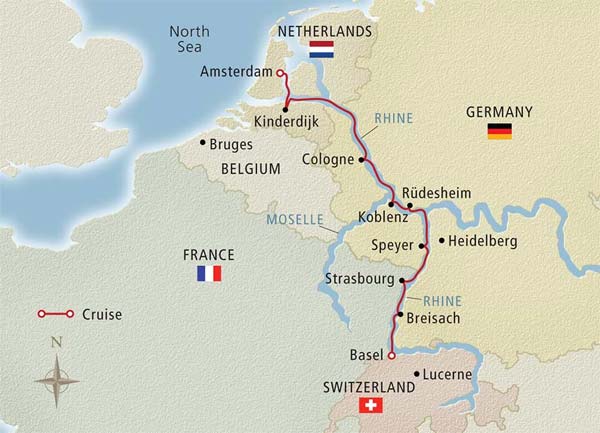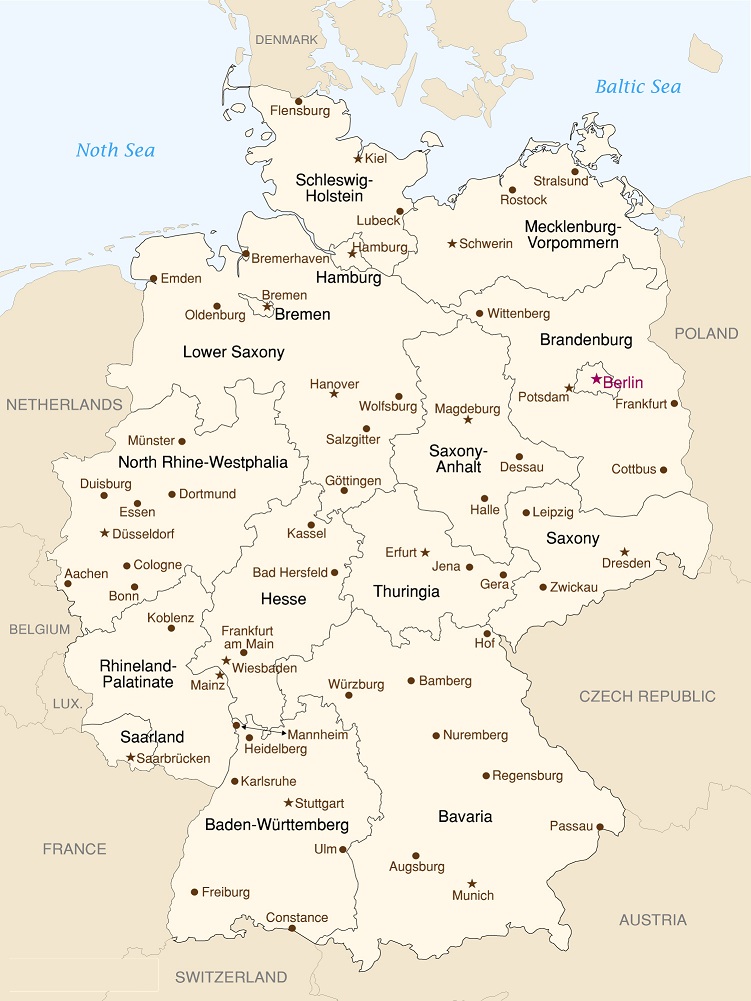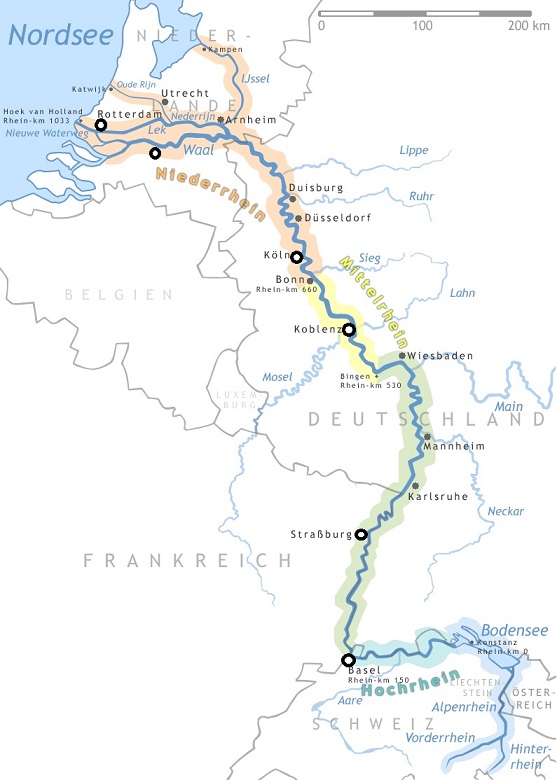There was continuity of settlement following the departure of the Romans in the 5th century. The Roman settlements were taken over by the Frankish kings and most of the area from Bingen downstream to Koblenz was crown property until well into the Carolingian era. However, the process of divesting the state of this property began in the 8th century and was not to be completed until the beginning of the 14th century. Much of it was donated to the church and the monastic orders. As bailiffs of the abbey of Prüm the Counts of Katzenelnbogen established control in the area around St Goar and Rheinfels, and this was to pass to the Landgraves of Hesse in 1479.
The Middle Rhine Valley was a core region of the Holy Roman Empire. Four of the seven Electors, the highest ranking rulers within the Empire, held portions of the area and it was here that they would meet to determine the succession.
Bacharach was the centre of the Rhine wine trade in the later Middle Ages. Vines had been cultivated on the lower slopes since Roman times, and this expanded greatly from the 10th century onwards. Some 3000ha of vineyards were under cultivation by 1600, five times as much as at the present time. The Thirty Years' War (1618-48) witnessed a substantial decline in viticulture, the land being converted partly into orchards and partly into coppice forest. The 14th-16th centuries were the golden age of art in the Middle Rhine, which saw the convergence of artistic influences from the Upper Rhine (Strasbourg) and the Lower Rhine (Cologne). Gothic masterpieces such as the Werner Chapel above Bacharach, the Church of Our Lady in Oberwesel, and the former collegiate church of St Goar date from this period.
A deliberate policy of promoting the Rhine as a "German" landscape was adopted by the Prussian state. This led to the renovation of fortress ruins in the Romantic style and the reconstruction of historic monuments, and also to the beginnings of the modern monument conservation movement.
The 20th century has seen major structural changes, notably the decline of the traditional winemaking sector and of mining and quarrying. Freight traffic has become concentrated on a small number of large harbours. The most important economic sector is now tourism. Ordinances of 1953 and 1978 have focused on the preservation of the cultural landscape, which is the main economic asset of the Middle Rhine.
 With the partition of Charlemagne's empire in 842 the left bank of the Rhine was assigned to the Middle Kingdom. Lorraine was not to be united with the East Frankish Kingdom until 925. It remained a heartland of royal power until the election of the Hohenstaufen King Konrad III in 1138. This saw the fragmentation of power in the Middle Rhine area, with parcels of land being distributed among the bishop-electors of Cologne, Mainz, and Trier and the counts palatine. Some forty castles were constructed between Bingen and Koblenz, as symbols of power and also as customs stations on this flourishing trade route. Towns such as Boppard and Oberwesel struggled to maintain their independent status as free towns, as testified by the remains of their defensive walls.
With the partition of Charlemagne's empire in 842 the left bank of the Rhine was assigned to the Middle Kingdom. Lorraine was not to be united with the East Frankish Kingdom until 925. It remained a heartland of royal power until the election of the Hohenstaufen King Konrad III in 1138. This saw the fragmentation of power in the Middle Rhine area, with parcels of land being distributed among the bishop-electors of Cologne, Mainz, and Trier and the counts palatine. Some forty castles were constructed between Bingen and Koblenz, as symbols of power and also as customs stations on this flourishing trade route. Towns such as Boppard and Oberwesel struggled to maintain their independent status as free towns, as testified by the remains of their defensive walls.
 Since the 17th century the Middle Rhine has been the scene of conflict between Germany and France. During the War of the Palatine Succession (1688-92) there was extensive destruction of fortresses and town fortifications, and much of Koblenz was destroyed. In the late 18th century the left bank of the Rhine became part of, first, the French Republic, and then the French Empire. This came to end in 1814, when the region came under Prussian rule. Extensive fortifications were constructed, including the fortress at Koblenz, and trade was fostered by the construction of the Rhine highway from Bingen to Koblenz, the widening of the shipping channel, the abolition of tolls over long stretches of the river, and the introduction of steam navigation. Railways were constructed on both the left and the right bank in the 1850s and 1860s.
Since the 17th century the Middle Rhine has been the scene of conflict between Germany and France. During the War of the Palatine Succession (1688-92) there was extensive destruction of fortresses and town fortifications, and much of Koblenz was destroyed. In the late 18th century the left bank of the Rhine became part of, first, the French Republic, and then the French Empire. This came to end in 1814, when the region came under Prussian rule. Extensive fortifications were constructed, including the fortress at Koblenz, and trade was fostered by the construction of the Rhine highway from Bingen to Koblenz, the widening of the shipping channel, the abolition of tolls over long stretches of the river, and the introduction of steam navigation. Railways were constructed on both the left and the right bank in the 1850s and 1860s.
The strategic location of the dramatic 65km stretch of the Middle Rhine Valley between Bingen, Rüdesheim und Koblenz as a transport artery and the prosperity that this engendered is reflected in its sixty small towns, the extensive terraced vineyards and the ruins of castles that once defended its trade.
The river breaks through the Rhenish Slate Mountains, connecting the broad floodplain of the Oberrheingraben with the lowland basin of the Lower Rhine. The property extends from the Bingen Gate (Binger Pforte), where the River Rhine flows into the deeply gorged, canyon section of the Rhine Valley, through the 15km long Bacharach valley, with smaller V-shaped side valleys, to Oberwesel where the transition from soft clay-slates to hard sandstone, results. In a series of narrows, the most famous of which is the Loreley, no more than 130m wide (and at 20m the deepest section of the Middle Rhine), and then up to the Lahnstein Gate (Lahnsteiner Pforte), where the river widens again into the Neuwied Valley. The property also includes the adjoining middle and upper Rhine terraces (Upper Valley) which bear witness to the course taken by the river in ancient times.
As a transport route, the Rhine has served as a link between the southern and northern halves of the continent since prehistoric times, enabling trade and cultural exchange, which in turn led to the establishment of settlements. Condensed into a very small area, these subsequently joined up to form chains of villages and small towns. For over a 1,000 years the steep valley sides have been terraced for vineyards.
The Rhine is one of the world's great rivers and has witnessed many crucial events in human history. The stretch of the Middle Rhine Valley between Bingen and Koblenz is in many ways an exceptional expression of this long history. It is a cultural landscape that has been fashioned by humankind over many centuries and its present form and structure derive from human interventions conditioned by the cultural and political evolution of Western Europe. The geomorphology of the Middle Rhine Valley, moreover, is such that the river has over the centuries fostered a cultural landscape of great beauty which has strongly influenced artists of all kinds - poets, painters, and composers - over the past two centuries.
Criterion (ii): As one of the most important transport routes in Europe, the Middle Rhine Valley has for two millennia facilitated the exchange of culture between the Mediterranean region and the north.
Criterion (iv): The Middle Rhine Valley is an outstanding organic cultural landscape, the present-day character of which is determined both by its geomorphological and geological setting and by the human interventions, such as settlements, transport infrastructure, and land use, that it has undergone over two thousand years.
Criterion (v): The Middle Rhine Valley is an outstanding example of an evolving traditional way of life and means of communication in a narrow river valley. The terracing of its steep slopes in particular has shaped the landscape in many ways for more than two millennia. However, this form of land use is under threat from the socio-economic pressures of the present day.
Integrity
The extensive property contains within its boundaries all the key attributes - the geological landscape, the sixty towns and settlements, the forty castles and forts, the vineyard terraces that define this prosperous and picturesque stretch of the Rhine valley and encompass all the key views that influenced writers and artists.
Authenticity
Thanks to the relatively modest leeway given by the natural landscape of the Middle Rhine Valley to the people inhabiting it, this section of the river has undergone fewer changes than others. As a result, but also thanks to various early attempts to protect the landscape and its historical monuments, the landscape has remained largely untouched. As a result, many of the features and elements that lend the area its authenticity have been preserved.
However the railways that run along the valley contribute to the noise pollution in the Valley which is a problem that needs to be mitigated.
Protection and management requirements
In Rhineland-Palatinate the monuments are covered by the 1978 Cultural Monuments Protection Law (Denkmalschutzgesetz) and the 1998 Building Ordinance (Landesbauordnung Rheinland-Pfalz). The landscape values are protected by the 2000 Forest Law (Landeswaldgesetz), 2005 Landscape Conservation Law (Landesgesetz zur nachhaltigen Entwicklung von Natur und Landschaft), 2003 Planning Law (Landesplanungsgesetz), 2004 Water Law (Landeswassergesetz), and the 1978 Middle Rhine Landscape Protection Ordinance (Landschaftsschutzverordnung Mittelrhein). Monuments in Hesse are covered by the 1976 Hesse Monuments Protection Law (Gesetz zum Schutz der Kulturdenkmäler) as amended in 1986. The 2002 Hesse Building Ordinance (Hessische Bauordnung) also has a significant role to play in monument protection. The landscape values are protected by a series of statutes, such as the 2002 Hesse Forest Law (Hessisches Forstgesetz), the 2006 Nature Protection and Landscape Conservation Law (Hessisches Gesetz über Naturschutz und Landschaftspflege), the 2002 Planning Law (Hessisches Landesplanungsgesetz), and the 2005 Water Law (Hessisches Wassergesetz).
Signatories of the Rhine Valley Charter (Die Rheintal Charta) of November 1997, which include the great majority of communities in the Middle Rhine Valley, undertake to conserve, manage, and exercise care in developing the natural and cultural heritage and the unique cultural landscape of the Rhine Valley.
Since 2005, the property has been run by the Upper Middle Rhine Valley World Heritage Association, which comprises representatives from all the local and 'county' authorities falling within the region, as well as including officials from the federal states of Hesse and Rhineland-Palatinate. The association also provides the property's World Heritage manager.
In 2004, the job of monitoring the implementation of the management plan in Rhineland-Palatinate was transferred to the state's Structural and Approval Directorate in Koblenz. The measures taken in the property serve primarily to preserve historical castles and towns, uphold the tradition of winegrowing on the steep slopes of the valley, secure habitats for rare animal and plant species, and generally ensure that the state of the environment remains unaltered. These measures are also designed to underpin the region's economic viability in a bid to dissuade people from moving away and prevent the average age of the region's inhabitants from rising.
To conciliate economic development to benefit local communities and the safeguarding of the Outstanding Universal Value of the property a Master Plan for the further sustainable development of the Upper Middle Rhine Valley World Heritage Site is about to be compiled.
Long Description
As one of the most important transport routes in Europe, the Middle Rhine Valley has for two millennia facilitated the exchange of culture between the Mediterranean region and the north. It is an outstanding organic cultural landscape, the present-day character of which is determined both by its geomorphological and geological setting and by the human interventions such as settlements, transport infrastructure, and land use that it has undergone over 2,000 years. As a result, it is an outstanding example of an evolving traditional way of life and means of communication in a narrow river valley. The terracing of its steep slopes in particular has shaped the landscape in many ways for more than two millennia. However, this form of land use is under threat from today's socio-economic pressures.
The appearance of the Middle Rhine Valley is characterized by the interaction between its physical natural features, the human interventions, and its 'tourist' image. In the 65 km stretch of the valley the river breaks through the Rhenish Slate Mountains, connecting the broad floodplain of the Oberrheingraben with the lowland basin of the Lower Rhine.
At the 5 km long Bingen Gate (Bingen Pforte), widened in the 19th and 20th centuries, the Rhine enters the upper canyon stretch of the river. Just before the Gate there are two small towns: Bingen on the left bank noteworthy for 'political' symbols, Rüdesheim on the right dominated by the 12th-century Brömserberg fortress. The vineyards of the Rüdesheimer Berg are among the best in the Rheingau. After the Bingen Gate comes the 15 km long Bacharach valley, which is indented with smaller V-shaped side valleys. The small town of Lorch extends at right angles to the Rhine up the valley, lined with terraced vineyards. It is notable for its fine Gothic parish church of St Martin. Bacharach, at the entrance of the Steeger valley contains many timber-framed houses and retains its medieval appearance. Kaub and its environs contain a number of monuments, among them the Pfalzgrafenstein castle, the town wall of Kaub itself, and the terraced vineyards, created in the Middle Ages. Oberwesel has preserved a number of fine early houses, as well as two Gothic churches, the medieval Schönburg castle, and its medieval town wall.
The valley landscape begins to change at Oberwesel with the transition from soft clay-slates to hard sandstone. The result is a series of narrows, the most famous of which is the Loreley. This stretch of river was once hazardous for shipping and is reputed to be the place where the fabulous treasure of the Niebelungs lies hidden. Across the river on the right bank is St Goarshausen, with its castle of Neu-Katzenelnbogen. The third Katzenelnbogen fortress is Burg Reichenberg; its design suggests that it may have been inspired by Crusader fortresses in Syria and Palestine. Bad Salzig on the left bank marks the beginning of the section known as the Boppard Loops (Bopparder Schlingen). On the right bank is the twin town of Kamp Bornhofen.
Located at the start of a horseshoe loop in the river, Boppard originated as a Roman way-station, and was replaced in the 4th century by a military fort. Beyond Boppard is Osterspai with its timber-framed houses from the 16th-18th centuries and a ruined moated castle. Oberspay and Niederspay have fused into a single town and contain more timber-framed houses than anywhere else on the Middle Rhine: there is a particularly fine group on the waterfront. On the left bank, Rhens is where the German Emperors were enthroned after being elected in Frankfurt and crowned in Aachen Cathedral. The fortress of Marksburg, along with Pfalzgrafenstein the only surviving medieval fortifications on the Middle Rhine, towers above Braubach. Although much altered after the coming of the railway in 1860, Lahnstein preserves its imposing parish church of St John the Baptist. The castle of Stolzenfels, which belonged to the Elector of Trier, was restored in 1835 by the Prussians. Of the buildings in Koblenz that survived severe aerial bombardment during the Second World War mention should be made of the Romanesque basilicas of St Kastor, Our Lady, and St Florin, and the New Castle, the first and most important early classicist building in the Rhineland.
 The landscape is punctuated by some 40 hill top castles and fortresses erected over a period of around 1,000 years. Abandonment and later the wars of the 17th century left most as picturesque ruins. The later 18th century saw the growth of sensibility towards the beauties of nature, and the often dramatic physical scenery of the Middle Rhine Valley, coupled with the many ruined castles on prominent hilltops, made it appeal strongly to the Romantic movement, which in turn influenced the form of much 19th century restoration and reconstruction.
The landscape is punctuated by some 40 hill top castles and fortresses erected over a period of around 1,000 years. Abandonment and later the wars of the 17th century left most as picturesque ruins. The later 18th century saw the growth of sensibility towards the beauties of nature, and the often dramatic physical scenery of the Middle Rhine Valley, coupled with the many ruined castles on prominent hilltops, made it appeal strongly to the Romantic movement, which in turn influenced the form of much 19th century restoration and reconstruction.
